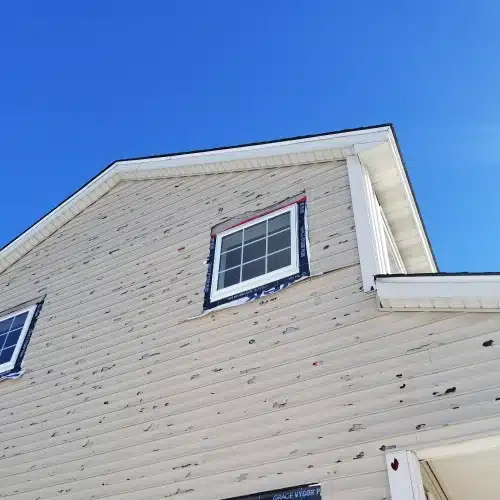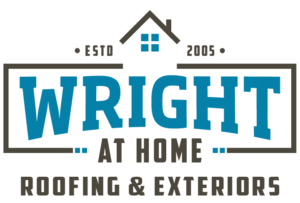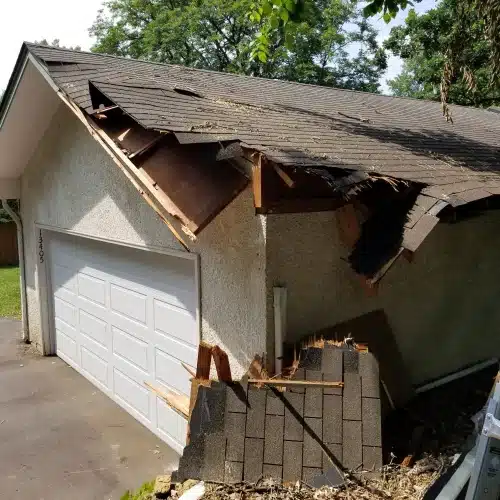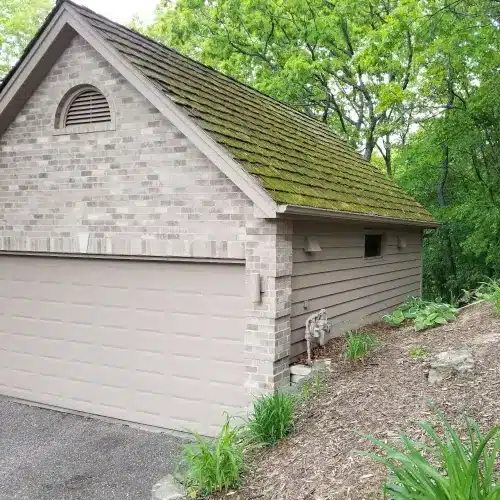Hail damage might look minor — but it can lead to leaks, mold, and costly repairs if ignored. Learn how to spot hidden roof damage after a Minnesota storm.
| Quick Summary Even if your roof looks fine after a Minnesota hailstorm, hidden damage could still be there. Small cracks, bruised shingles, and granule loss may not leak right away—but over time, they can cause accelerated aging of your roof system, create the potential for leaks, and even lead to denied insurance claims in the future if left unassessed. A fast inspection helps prevent minor hail damage from turning into costly repairs. |

Why Roof Hail Damage Often Goes Undetected in Minnesota
At Wright at Home Roofing & Exteriors, we know Minnesotans are no strangers to hailstorms. While the damage they leave behind can be dramatic, it’s often what you don’t see that causes the most trouble. Even if your roof looks fine from the ground, subtle hail impacts can weaken your roof’s structure and create long-term problems—including hidden leaks, attic damage, and denied insurance claims.
The biggest danger of hail damage? It hides in plain sight—and gets worse over time if ignored.
Hairline Shingle Fractures
Hail can create tiny, almost invisible cracks in your shingles. While they may not look serious, these fractures break the protective granule coating on your roof, making it easier for the sun’s UV rays to deteriorate your roof system. Over time, they compromise the roof’s ability to shed water, increasing the risk of leaks.
Bruised or Compressed Underlayment
Even if your shingles appear intact, a strong hail impact can bruise the layers beneath them. This damage weakens the structure of your roofing system and may not become apparent until moisture begins to soak through, leading to rot, mold, or attic insulation damage.
Granule Loss
Granules are the protective top layer of asphalt shingles, shielding them from sun damage and weathering. Hail can knock these granules loose, leaving your shingles exposed to harmful UV rays. This speeds up the aging process, dries out the asphalt, and causes your shingles to crack or curl prematurely.
Delayed Leaks and Moisture Intrusion
One of the most misleading aspects of hail damage is the lack of immediate symptoms. You might not see any leaks for weeks—or even months—but that doesn’t mean water isn’t slowly working its way in. By the time you notice stains on your ceiling or mold in your attic, the damage is often widespread.
How Hail Damage Leads to Bigger Roof Problems
When hail or storm damage goes unrepaired, it doesn’t just risk leaks—it invites even bigger problems.
Vulnerable Roofs Attract Unwanted Guests
Hail can loosen shingles, crack flashing, or create small holes in your roof—perfect entry points for pests like squirrels, birds, or raccoons. Once inside, these animals can:
- Tear insulation and wiring
- Nest in your attic
- Spread bacteria and parasites
- Worsen leaks by burrowing or enlarging openings
Storm damage might be the root cause, but wildlife quickly makes it worse—and more expensive to fix.
Moisture Leads to Moss & Lichen
When hail compromises your roof’s protective barrier, moisture gets trapped beneath shingles. Over time, this creates a damp, shaded environment where moss and lichen thrive. These growths can:
- Accelerate roof rot and shingle decay
- Lift shingles and expose the underlayment
- Trigger allergies and respiratory issues indoors
What starts as a few green patches can turn into full-blown deterioration if not addressed.
Bottom line: Hail damage doesn’t just weaken your roof—it sets the stage for further threats. Acting fast prevents a small problem from becoming a costly, multi-layered repair.
What Happens If You Don’t Repair Hail Damage?
Ignoring roof hail damage can turn a manageable issue into a full-blown headache. Here’s what’s at stake:
- Moisture intrusion that causes interior water damage and ceiling stains
- Mold growth and attic rot, especially in poorly ventilated areas
- Insurance claim denial if damage isn’t reported promptly
- Premature roof failure, costing you thousands in early replacement
Signs You May Have Hail Damage (Even If You Can’t See It)
Think your roof is fine? Take a second look:
- Granules in your gutters or downspouts
- Dented gutters, flashing, or roof vents
- Dark bruises or soft spots on shingles
Even if you don’t notice leaks, these signs can signal serious trouble brewing beneath the surface.
How Wright at Home Roofing & Exteriors Can Help
As a local, family-owned company based in the Minneapolis metro, Wright at Home Roofing & Exteriors knows what Minnesota roofs go through. We specialize in storm damage repair and work hard to make the process simple and stress-free.
Here’s how we help:
- Free roof inspections after a hailstorm
- Expert documentation to support your insurance claim
- Storm damage repair specialists serving Minneapolis suburbs
- Guidance through the claims process so nothing falls through the cracks
If you’re unsure how to navigate the insurance process, the Minnesota Department of Commerce offers helpful guidance on filing a residential property claim.
We’re here to protect your home—and your peace of mind.
Don’t Wait for a Leak—Schedule a Free Hail Damage Inspection Today
Hail the size of a quarter or larger can significantly damage your home’s roof system. Catch issues early and avoid costly surprises by scheduling a no-obligation storm damage inspection with our team. Serving the Minneapolis area for more than 15 years!
FAQs
Q: How long after a hailstorm should I get a roof inspection?
A: You should schedule a roof inspection as soon as possible—ideally within a few days to a couple of weeks after the storm. Many insurance providers require damage to be documented promptly to approve a hail damage claim.
Q: Does insurance cover hail damage to my roof in Minnesota?
A: In most cases, yes. Homeowners’ insurance typically covers roof hail damage in Minnesota, but coverage can vary by provider and policy. Timely inspection and accurate documentation are essential to avoid claim denial.
Q: What are the most common signs of hail damage on a roof?
A: Look for loose granules in gutters, dents in flashing or vents, soft or bruised shingles, and dark spots on your roof.
Q: Can hail damage cause roof leaks even if I don’t see them right away?
A: Yes. Hail damage often weakens the roof’s protective layers without causing immediate leaks. Over time, water can penetrate the underlayment and lead to attic moisture, mold growth, or ceiling stains.
Q: Why should I use a local roofing contractor for hail damage repair?
A: Local contractors like Wright at Home Roofing & Exteriors understand Minnesota weather patterns and building codes. We offer fast response times, free inspections, and personalized help navigating the insurance process.
Disclaimer: Wright at Home Roofing & Exteriors does not act as insurance adjusters and cannot guarantee coverage or policy decisions. Please consult your insurance provider for specific policy details. This blog is intended for informational purposes only and should not be construed as professional insurance advice.





